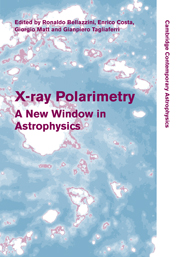Book contents
- Frontmatter
- Contents
- List of contributors
- Preface
- 1 X-ray polarimetry: historical remarks and other considerations
- Part I Polarimetry techniques
- Part II Polarized emission in X-ray sources
- Part III Future missions
- 37 Gravity and Extreme Magnetism SMEX (GEMS)
- 38 Programs of X-ray polarimetry in Italy
- 39 A polarimeter for IXO
- 40 Polarimetry with ASTRO-H soft gamma-ray detector
- 41 The Energetic X-ray Imaging Survey Telescope and its polarization sensitivity
- 42 PoGOLite: a balloon-borne soft gamma-ray polarimeter
- 43 Studies of neutron background rejection in the PoGOLite polarimeter
- 44 Observing polarized X-rays with PoGOLite
- 45 Pre-flight qualification tests of the PoGOLite detector system
- 46 The Gamma-RAy Polarimeter Experiment (GRAPE) balloon payload
- 47 POLAR: an instrument dedicated to GRB polarization measurement
- 48 Polarization detection capability of GRIPS
- 49 X-ray and γ-ray polarimetry small-satellite mission PolariS
- 50 GAP aboard the solar-powered sail mission
- 51 Hard X-ray polarimeter for small-satellite missions
- 52 Performance of hard X-ray polarimeter: PHENEX
- 53 GRB polarimetry with POET
- Author index
- Subject index
41 - The Energetic X-ray Imaging Survey Telescope and its polarization sensitivity
from Part III - Future missions
Published online by Cambridge University Press: 06 July 2010
- Frontmatter
- Contents
- List of contributors
- Preface
- 1 X-ray polarimetry: historical remarks and other considerations
- Part I Polarimetry techniques
- Part II Polarized emission in X-ray sources
- Part III Future missions
- 37 Gravity and Extreme Magnetism SMEX (GEMS)
- 38 Programs of X-ray polarimetry in Italy
- 39 A polarimeter for IXO
- 40 Polarimetry with ASTRO-H soft gamma-ray detector
- 41 The Energetic X-ray Imaging Survey Telescope and its polarization sensitivity
- 42 PoGOLite: a balloon-borne soft gamma-ray polarimeter
- 43 Studies of neutron background rejection in the PoGOLite polarimeter
- 44 Observing polarized X-rays with PoGOLite
- 45 Pre-flight qualification tests of the PoGOLite detector system
- 46 The Gamma-RAy Polarimeter Experiment (GRAPE) balloon payload
- 47 POLAR: an instrument dedicated to GRB polarization measurement
- 48 Polarization detection capability of GRIPS
- 49 X-ray and γ-ray polarimetry small-satellite mission PolariS
- 50 GAP aboard the solar-powered sail mission
- 51 Hard X-ray polarimeter for small-satellite missions
- 52 Performance of hard X-ray polarimeter: PHENEX
- 53 GRB polarimetry with POET
- Author index
- Subject index
Summary
EXIST (Energetic X-ray Imaging Survey Telescope) is a proposed spaceborne observatory that combines a wide-field-of-view X-ray telescope (5–600 keV) with a pointed optical/infrared telescope, and possibly with a soft-X-ray telescope contributed by Italian collaborators. The primary science drivers of EXIST are the study of the high-redshift Universe and the epoch of re-ionization through the detection and follow-up observations of high-redshift gamma-ray bursts (GRBs) at z ∼ 10, the study of supermassive black holes in galaxies (including heavily obscured and dormant black holes), and the study of stellar-mass and intermediatemass black hole populations in the Milky Way galaxy and in the Local Group. In this contribution, we discuss the polarimetric capabilities of the EXIST hard X-ray telescope. Based on a pointed five-day observation (or based on four-months all-sky survey observations), EXIST can detect the hard X-ray polarization of 100 mCrab sources for polarization degrees down to 6%. The wide field of view of EXIST will make it possible to measure the polarization of transient events like GRBs and flaring galactic and extragalactic sources. We discuss the scientific potential of the hard-X-ray polarimetric measurements. The EXIST observations would allow us to (i) obtain qualitatively new constraints on the locale of particle acceleration in the vicinity of compact objects, (ii) gain key insights into the structure of jets from GRBs and active galactic nuclei, (iii) test high-order QED predictions in the extreme magnetic fields of neutron stars, and (iv) search for quantum gravity signatures (the helicity-dependence of the speed of light) with unprecedented sensitivity.
- Type
- Chapter
- Information
- X-ray PolarimetryA New Window in Astrophysics, pp. 284 - 290Publisher: Cambridge University PressPrint publication year: 2010



